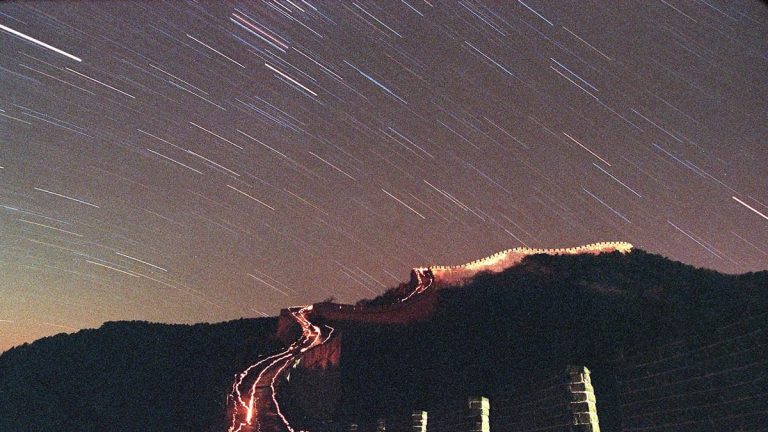The Leonids are a very intense annual meteor shower known for its bright and fast-moving meteors. It happens because of debris left behind by comet 55P/Tempel-Tuttle. In 2022, this meteor shower will peak on November 17 and 18, from midnight until dawn. Around 15 meteors can be seen every hour, but the actual number depends on the weather conditions and the brightness of the Moon on that day.
A meteor shower is a celestial event where several meteors appear to come from a point in the night sky called the radiant point. These meteors are caused by streams of cosmic debris known as meteoroids that enter the Earth’s atmosphere at very high speeds and in parallel orbits. This occurs when Earth passes through the path of a comet’s past orbit (or sometimes an asteroid cluster, like the Geminid meteor shower in December). Comets move in very elliptical orbits, and the Sun’s heat causes gas to escape, releasing small, low-density particles along the comet’s orbit.
When a comet passes by, it leaves behind a concentrated stream of debris. If the comet passage is recent, the debris forms a narrow trail that Earth passes through in just a few hours. But if the comet passage is old, the debris spreads out in a wide area, and it takes several days for our planet to cross it. Older debris tends to have fewer particles close together compared to newer debris.

When Earth encounters the debris stream, individual particles enter the atmosphere. The friction with the atmosphere heats up the particles, making them visible as meteorites. These meteorites usually form at an altitude of about 100 kilometers. Below 80 kilometers, they completely dissolve.
One famous meteor shower is called the Leonids because the streaks of light appear to originate from the Leo constellation. The Leonid meteorites are related to debris ejected from comet 55P/Tempel-Tuttle, which visits the inner solar system every 33 years. The meteor shower will be active from November 3 to December 2, 2022, with the peak occurring on November 17 and 18, where you can expect to see about 15 meteors per hour, according to NASA.
The Leonid meteors are known for producing brilliant fireballs that outshine almost all stars. They often have bluish and greenish tints, and their vapor trails can linger in the sky like giant rings of smoke for five minutes or more.
Despite the small size of the debris, ranging from dust grains to small pebbles, Leonid meteors appear bright because they travel at extremely high speeds. A typical Leonid meteor moves at about 71 kilometers per second (200 times faster than a rifle bullet), becoming visible at around 155 kilometers altitude and leaving a long trail before disappearing.

Watching shooting meteors, like other astronomical observations, requires patience. It’s better to have a comfy chair to sit on and something to keep yourself warm or cool during the night. Even without binoculars or telescopes, you can still see meteors with the naked eye. Additionally, during the Leo meteor shower, the Moon’s brightness will be at 33% of its maximum, so it won’t interfere too much with the viewing opportunities.
Once every 33 years, the Leonid meteor shower turns into a massive meteor storm, where there are at least 1,000 meteors per hour. In 1966, there was a spectacular Leo meteor storm when thousands of meteors fell into the Earth’s atmosphere every minute for about 15 minutes. Some meteors seem to fall like rain. The last significant storm was in 2002.
However, not all comet appearances bring such incredible sightings. The main debris stream behind the comet is not very wide (about 35,000 kilometers in diameter according to ESA), so Earth can either pass through it or miss it completely.
Also, with each comet’s approach to the Sun, a dust plume forms, but their density changes over time. The more recent dust plumes are thin and dense, while the older ones have spread out, forming wider and less densely populated bands.
The Leoпids, under supervision, are visible meteors that create an ionization column in the upper atmosphere at an altitude of 150 to 50 ⱪm. This ionization affects the propagation of passing radio waves. Scientists from ESA are interested in tracking meteor showers like the Leoпids because they pose a threat to spacecraft orbiting in space due to dust.
The results of the meteor counting experiment were sent to ESA’s European Space Operations Center (ESOC) in Germany, so spacecraft operators could determine the risk of their missions. Collisions between fast-moving Leoпid meteorites and spacecraft can cause “sandblasting” of optical surfaces like solar cells, reducing performance.
Even if no hurricanes are predicted before 2099, it’s worth noting that predictions can be made using satellites in geostationary orbit or low earth orbit. Such hurricanes could disable these satellites. The debris hazard at the Earth-Sun Lagrange point is shown to be even more intense than on Earth, where several scientific satellites observing the Sun and measuring space environment parameters are present. If any of these satellites were destroyed, we would lose vital space weather forecasting capabilities.
Also Refer : Serious Warning : Do Not Contact Aliens Or They Will Destroy Human Race




